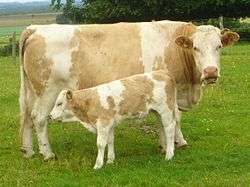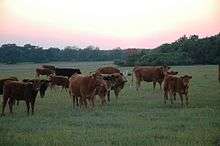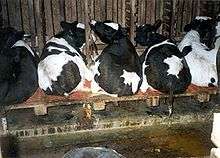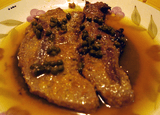Veal


Veal is the meat of calves, in contrast to the beef from older cattle. Veal can be produced from a calf of either sex and any breed; however, most veal comes from young males of dairy breeds[1] because these are surplus to the industry's requirements. Generally, veal is more expensive than beef from older cattle.
Some methods or aspects of veal production are controversial due to animal welfare concerns.
Types

There are several types of veal, although some terminology varies by country. Types of veal include:
- Bob veal
- Calves are slaughtered when only a few weeks old (at most 1 month old) weighing up to 60 lb.[2]
- Formula-fed ("white" or "milk-fed") veal
- Calves are raised on a milk formula supplement. The meat colour is ivory or creamy pink, with a firm, fine, and velvety appearance. The calves are usually slaughtered when they reach 18 to 20 weeks of age, weighing 450 to 500 pounds (200 to 230 kg).[3]
- Nonformula-fed ("red" or "grain-fed") veal
- Calves that are raised on grain, hay, or other solid food, in addition to milk. The meat is darker in color, and some additional marbling and fat may be apparent. It is usually marketed as calf, rather than veal. The calves are slaughtered at 22 to 26 weeks of age weighing 650 to 700 pounds (290 to 320 kg).[4]
- Rose veal (in the UK)
- Young beef (in Europe)
- Calves raised on farms in association with the UK Royal Society for the Prevention of Cruelty to Animals' Freedom Food programme. The name comes from the pink color, which is partly a result of the calves being slaughtered later at about 35 weeks of age.[5]
- Pasture-raised veal
- Special-fed veal
- Calves are fed a balanced milk or soy-based diet, fortified with 40 essential nutrients, including essential amino acids, carbohydrates, fats, dietary iron and other dietary minerals and vitamins. As of 2013, the majority of veal calves in the US are special-fed.[6]
Culinary uses
Veal has been an important ingredient in Italian and French cuisine from ancient times. The veal is often in the form of cutlets, such as the Italian cotoletta or the famous Austrian dish Wiener Schnitzel. Some classic French veal dishes include fried escalopes, fried veal Grenadines (small, thick fillet steaks), stuffed paupiettes, roast joints, and blanquettes. Because veal is lower in fat than many meats, care must be taken in preparation to ensure that it does not become tough. Veal is often coated in preparation for frying or eaten with a sauce. Veal Parmigiana is a common Italian-American dish made with breaded veal cutlets.
In addition to providing meat, the bones of calves are used to make a stock that forms the base for sauces and soups such as demi-glace. Calf stomachs are also used to produce rennet, used in the production of cheese. Calf offal is also widely regarded as the most prized animal offal.[7] Most valued are the liver, sweetbreads, kidney, and bone marrow. The head, brains, tongue, feet, and mesentery are also valued.
Production
At birth
Male dairy calves are commonly used for veal production as they do not lactate[8] and are therefore surplus to the requirements of the dairy industry.
Newborn veal calves are generally given only a limited amount of time with their mothers, varying from a few hours to a few days. Free-raised calves are raised alongside their mothers, and always have access to their mothers' milk.
Housing
Three different primary types of housing used for veal calves: hutches, stalls, or various types of group housing.
Feeding
"Milk-fed" veal calves consume a diet consisting of milk replacer, formulated with mostly milk-based proteins and added vitamins and minerals. This type of diet is similar to infant formula and is also one of the most common diets used for calves in the veal industry.[8][9]
"Grain-fed" calves normally consume a diet of milk replacer for the first six to eight weeks and then move on to a mostly corn-based diet.
Free-raised calves are raised on an open pasture and receive a diet of milk, grass, and fresh water. Furthermore, free-raised calves do not receive antibiotics, which are often a focus of criticism amongst animal welfare organizations.[9]
Controversy
Animal welfare

Some methods of veal production are controversial due to animal cruelty. Multiple animal welfare organizations consider several practices and procedures of veal production to be inhumane. Public efforts by these organizations are placing pressure on the veal industry to change some of its methods.[9][10][11]
Some inhumane practices are relevant to both group and in individually housed systems.
Restricted space
One example of cruelty in the veal industry, is the lack of space veal calves are provided. Space is often deliberately restricted by the producer to stop the animal exercising as this makes the meat turn redder and tougher.[12]
Abnormal gut development
Some systems of veal production rear calves that are denied access to any solid feed[13] and are fed a liquid milk replacer. They may also be deprived of bedding to prevent them from eating this. This dietary restriction completely distorts the normal development of the rumen and predisposes the calf to infectious enteritis (scouring or diarrhoea) and chronic indigestion.[14] Furthermore, calves with an underdeveloped gut are more likely to be found to have hairballs in the rumen at slaughter; the accumulation of hairballs in the rumen can impair digestion.[11]
Abnormal behaviours
Rearing calves in deprived conditions without a teat can lead to the development of abnormal oral behaviour. Some of these may develop into oral stereotypies such as sucking, licking or biting inanimate objects, and by tongue rolling and tongue playing. "Purposeless oral activity" occupies 15% of the time in crated calves but only 2–3% in group-housed calves.[11]
Increased disease susceptibility
Veal calves' dietary intake of iron is restricted[13] to achieve a target haemoglobin concentration of around 4.6 mmol/l; normal concentration of haemoglobin in the blood is greater than 7 mmol/l. Calves with blood haemoglobin concentrations of below 4.5 mmol/l show clear signs of increased disease susceptibility and immunosuppression.[11]
Alternative agricultural uses for male dairy calves include raising bob veal (slaughtered at two or three days old),[15] raising calves as "red veal" without the severe dietary restrictions needed to create pale meat (requiring fewer antibiotic treatments and resulting in lower calf mortality),[16] and as dairy beef.[17]
In 2008 to 2009 in the US, the demand for free-raised veal rose rapidly.[18][19]
Veal crates
Veal crates are a close-confinement system of raising veal calves. Many calves raised for veal, including in Canada[20] and the US, are confined in crates which typically measure approximately 66–76 cm (2.1-2.5 ft) wide. The calves are housed individually and the crates usually prevent physical contact between adjacent calves, and often prevent visual contact.[14] Crated calves are sometimes tied to the front of the crate with a short tether which restricts almost all movement.[10][14][21] Floors are often slatted and sloped. This allows urine and manure to fall under the crate to help maintain a clean environment for the calf. In some veal crate systems, the calves are also kept in the dark without bedding and fed nothing but milk.[22][23] Veal crates are designed to limit movement of the animal because meat turns redder and tougher if the animals are allowed to exercise.[12] The diet is sometimes highly regulated to remove sources of iron, which again makes the meat redder.
In the US, the use of crates to prevent movement by veal calves is a principal source of controversy in veal farming. Many veal farmers started improving conditions in their veal farms in the 2000s.[18][24] Veal crating is criticized because the ability of the calves to move is highly restricted; the crates have unsuitable flooring; the calves spend their entire lives indoors, experience prolonged sensory, social, and exploratory deprivation; and the calves are more susceptible to high amounts of stress and disease.[9]
Cruelty to calves
Abnormal bone and muscle development: Calves need to exercise to ensure normal bone and muscle development. Calves at pasture not only walk but also run about, jump and play. Calves in veal crates cannot turn around let alone walk or run. When finally taken out of their crates to go for slaughter, calves may stumble or have difficulty walking. There is a general increase in knee and hock swelling as crate width decreases.[11]
Social deprivation: Under natural conditions calves continue to suckle 3 to 6 times a day for up to 5 months.[11] Clearly, veal crates prevent this social interaction. Furthermore, many calves are reared in crates with solid walls that prevent visual or tactile contact with their neighbours. It has been shown that calves will work for social contact with other calves.[21]
To maintain personal hygiene and help prevent disease, calves lick themselves to groom. Cattle naturally lick all the parts of their body they can reach, however, tethering prevents calves from licking the hind parts of their body. Excessive licking of the forelegs (another abnormal behaviour) is common in stall and tether systems.[21]
Drug use
United States Department of Agriculture (USDA) regulations do not permit the use of hormones on veal calves for any reason. They do, however, approve the use of antibiotics in veal raising to treat or prevent disease.[25]
In 2004, the USDA expressed concern that the use of illegal drugs might be widespread in the veal industry.[26] In 2004, a USDA official found a lump on a veal calf in a Wisconsin veal farm, which turned out to be an illegal hormone implant.[26] In 2004, the USDA stated "Penicillin is not used in calf raising: tetracycline has been approved, but is not widely used."[25]
Crate bans
Europe
In 1990, the British government banned transporting calves in close-confinement crates.[22][23] Veal crates were banned across the EU in January 2007.[13][27][28]
Veal calf production, as such, is not allowed in many northern European countries, such as in Finland. In Finland, giving feed, drink or other nutrition which is known to be dangerous to an animal which is being cared for is prohibited, as well as failing to give nutrients the lack of which is known to cause the animal to fall ill. The Finnish Animal Welfare Act of 1996[29] and the Finnish Animal Welfare Decree of 1996[30] provided general guidelines for the housing and care of animals, and effectively banned veal crates in Finland. Veal crates are not specifically banned in Switzerland, but most calves are raised outdoors.[31][32]
United States
In 2007, the American Veal Association passed a resolution encouraging the entire industry to phase out crate confinement of calves by 2017.[33]

US States with bans on veal crates
Laws prohibiting veal crates
|
As of 2015, eight US states ban veal crates. Nationally, several large veal producers and the American Veal Association are also working to phase out the industry use of veal crates. State-by-state veal crate bans are as follows:[34]
- Arizona (since 2012, a part of Proposition 204)[35]
- California (effective 2015, a part of Proposition 2)
- Colorado (since 2012)[36]
- Kentucky (Passed in 2014, the Kentucky Livestock Care Standards Commission issued a decision to begin a phase-out period of four years and that by 2018 veal crates will be completely eliminated from Kentucky farms)[37]
- Maine (since 2011)[38]
- Michigan (effective 2013)[39]
- Ohio (passed 2010, effective 2017)[40]
- Rhode Island (since July 2013)[41]
Current active legislation in:
- New York (proposed in Jan. 2013 and 2014)[42]
- Massachusetts (House[43] and Senate[44] bills filed annually since 2009; current bills would take effect one year after passage)
See also
Further reading
- Costa, J.H.C., von Keyserlingk, M.A.G. and Weary, D.M. (2016). Invited review: Effects of group housing of dairy calves on behavior, cognition, performance, and health. Journal of Dairy Science, 99(4), 2453-2467.
References
- ↑ Stacey, Caroline. "Is veal cruel?". BBC Food - Food matters. BBC. Archived from the original on 2007-05-29. Retrieved 2013-08-12.
- ↑ "Veal". Encyclopaedia Britannica. Retrieved 2013-08-12.
- ↑ "Milk-fed veal definition". Ontario Veal Association. Retrieved 2013-08-12.
- ↑ Grain-Fed definition in Recommended Code of Practice for Raising Farm Animals from carc-crac.ca Archived August 6, 2007, at the Wayback Machine.
- ↑ Hickman, Martin (September 2, 2006). "The ethics of eating: The appeal of veal". Independent News and Media Limited. Archived from the original on 2007-10-12.
- ↑ LeTrent, Sarah (August 6, 2013). "Targeting consumers' beef with veal". Eatocracy (blog). CNN. Retrieved 2013-08-12.
- ↑ Montagné, P.: New Concise Larousse Gatronomique, page 1233. Hamlyn, 2007.
- 1 2 "Veal Farm Questions and Answers". Vealfarm.com. Retrieved 2015-10-03.
- 1 2 3 4 HSUS Welfare of Veal Calves Archived October 30, 2010, at the Wayback Machine.
- 1 2 "Veal crates". The Humane Society of the United States. March 22, 2016. Retrieved April 19, 2016.
- 1 2 3 4 5 6 McKenna, C. (2001). "The case against the veal crate: An examination of the scientific evidence that led to the banning of the veal crate system in the EU and of the alternative group housed systems that are better for calves, farmers and consumers" (PDF). Compassion in World Farming. Retrieved April 19, 2016.
- 1 2 Butler, C. (December 14, 1995). "Europe plan for ban on veal crates". The Independent. Retrieved April 19, 2016.
- 1 2 3 Compassion In World Farming. "About calves reared for veal". Compassion In World Farming. Retrieved April 15, 2016.
- 1 2 3 Greter, A. & Levison, L. (2012). "Calf in a box: Individual confinement housing used in veal production" (PDF). British Columbia Society for the Prevention of Cruelty to Animals. Retrieved April 19, 2016.
- ↑ Canadian Coalition for Farm Animals, 1997
- ↑ Sargeant JM, Blackwell TE, Martin W, et al. Production indicates, calf health and mortality on seven red veal farms in Ontario. Can J Vet Res 1994;58:196-201.
- ↑ Maas J, Robinson PH. Preparing Holstein steer calves for the feedlot. Vet Clin Food Anim 2007;23:269-279
- 1 2 Black, Jane (October 28, 2009). "The kinder side of veal". Washington Post.
- ↑ HSUS - Strauss and Marcho veal crates Archived August 12, 2009, at the Wayback Machine.
- ↑ Humane Society International. "Fast facts on veal crates in Canada". Humane Society International. Retrieved April 19, 2016.
- 1 2 3 "An HSUS Report: The Welfare of Intensively Confined Animals in Battery Cages, Gestation Crates, and Veal Crates" (PDF). The Humane Society of the United States. 2012. Retrieved April 19, 2016.
- 1 2 Bentham J. (September 5, 2007). "Veal, without the cruelty". The Guardian. Retrieved April 15, 2016.
- 1 2 Atkins, L. (July 28, 2000). "For the love of veal". The Guardian.
- ↑ Burros, Marian (April 18, 2007). "Veal to Love, Without the Guilt". New York Times.
- 1 2
- 1 2 Weise, Elizabeth (March 28, 2004). "Illegal hormones found in veal calves". USA Today. Retrieved 2013-08-12.
- ↑ "CIWF on Veal Crates (UK ban on bottom of page)". CIWF.org.uk. 2008-05-19. Retrieved 2013-08-12.
- ↑
- ↑ "Finnish Animal Welfare Act of 1996" (PDF).
- ↑ "The Finnish Animal Welfare Decree of 1996" (PDF).
- ↑ "Natura Veal". Retrieved 20 October 2013.
- ↑ "swiss meat - animal protection". Retrieved 20 October 2013.
- ↑ "Timeline of Major Farm Animal Protection Advancements". 8 September 2014. Retrieved 7 March 2015.
- ↑ "Veal Crates: Unnecessary and Cruel". 22 February 2013. Retrieved 7 March 2015.
- ↑ "Arizona Makes History for Farm Animals" May 2007
- ↑ ""Colorado bans the veal crate and the gestation crate", Compassion in world farming". Ciwf.org.uk. 2008-05-19. Retrieved 2013-08-12.
- ↑ http://vegnews.com/articles/page.do?pageId=6428&catId=8
- ↑ "Maine Bans Veal Crates" The Exception magazine
- ↑ "Michigan Adopts Law to Ban Gestation Stalls". Aasv.org. 2009-10-14. Retrieved 2013-08-12.
- ↑ "Landmark Ohio Animal Welfare Agreement Reached Among HSUS, Ohioans for Humane Farms, Gov. Strickland, and Leading Livestock Organizations". 30 June 2010. Retrieved 7 March 2015.
- ↑ Meier, Erica (June 21, 2012). "Victory: Rhode Island Bans Gestation Crates, Veal Crates, and Tail-Docking of Cows". Cok.net. Retrieved 2013-08-12.
- ↑ http://open.nysenate.gov/legislation/bill/A424-2013
- ↑ Lewis, Jason. "Bill H.1456 An Act to prevent farm animal cruelty". Retrieved 2013-10-22.
- ↑ Hedlund, Robert. "Bill S.741 An Act to prevent farm animal cruelty". Retrieved 2013-10-22.
External links
| Wikibooks Cookbook has a recipe/module on |
| Look up veal in Wiktionary, the free dictionary. |
- Ontario Veal Association — Ontario veal industry in Canada.
- Thinking Outside the Box — Dutch veal farming from Beef magazine
- Welfare Implications of Veal Calf Husbandry from the American Veterinary Medical Association (PDF format, October 2008)
- VealFarm.com — Veal industry in the USA
- Veal Recipes. A collection of recipes for various cuts of veal, tips on cooking, selection and handling of veal



